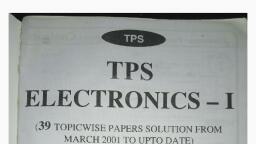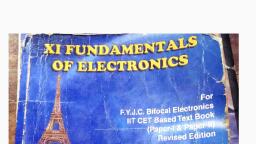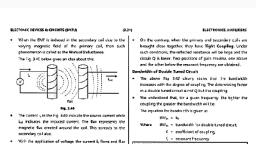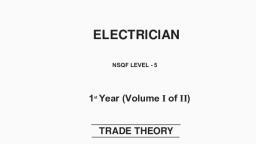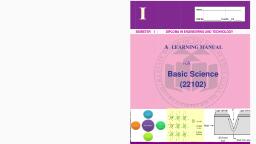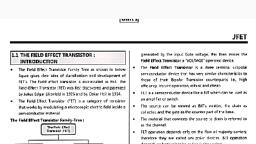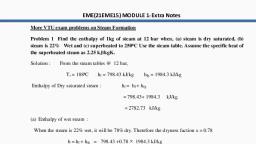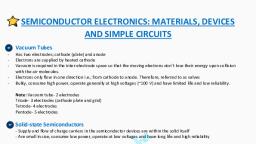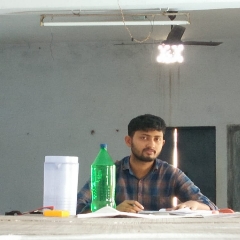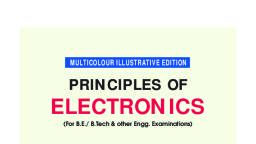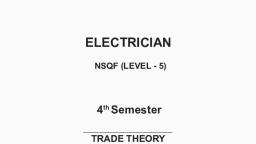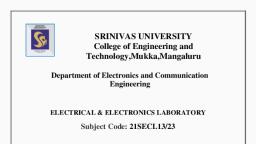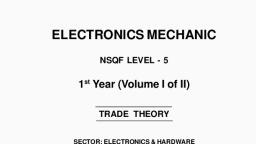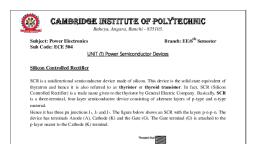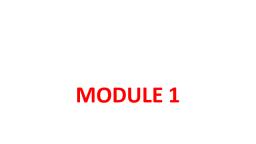Page 1 :
XI FUNDAMENTALS, OF ELECTRONICS, For, F.Y.J.C. Bifocal Electronics, IIT CET Based Text Book, (Paper-l& Paper-II), Revised Edition, R. D. SUPEKAR, 1
Page 2 :
CONTENTS, TAL, PAPER I: BASIC ELECTRICITY AND COMPONENTS, 1., 1-35, BASIC ELECTRICITY AND NETWORK THEOREMS, Review of Electricity- Sources of Electricity- Internal impedance of Source, Concept of, voltage and current source- Power-, Kirchhoff's current and voltage law- Superposition, theorem- Thevenin's theorem- Norton's theorem- Maximum power transfer theorem-, Electromagnetism., 1., 36-58, АС ТHEORY, Comparison of AC with DC-Generation of AC- The sine wave, alternating current,, voltage and current values for a sine wave- Amplitude frequency, period, wavelength,, phase angle, the time factor in frequency and phase- Non-sinusoidal AC waveforms- 50, HZ AC power time (Phase, neutral and ground)- Concept of impedance and reactance-., Series and Parallel Resonance., 2., 59-72
Page 3 :
BASIC ELECTRICITY AND, NETWORK THEOREMS, INTRODUCTION, This chapter is very fundamental and useful for the students who really want to, learn electricity and electronic circuits. After completing this topic and solving different, network problems one can easily analyse any complex electrical circuit by applying basic, laws and theorems like Ohm's law, Kirchoff s law and theorems. A brief review is also, included to know about different terminologies, simple formulae and clear concept of two, similar quantities. Some of these topics might be completed in Xh standard but it is, included under the subject physics. In physics, all concepts are explained theoretically, but while studying engineering subject like electronics it must be studied with certain, depth and concepts from practical application point of view. Hence, this year the same, topics have been illustrated with more pictorial form and with illustrative examples., 1.1 BRIEF REVIEW OF ELECTRICITY, Before studying the circuit laws and Network theorems let us have brief revision, of basic electrical quantities, units and conversions., TA, Glass Tube TR, V, -Tlov, .R., (b), (a), d vanup TA, Тв, TB, I = 0, (d), (c), Fig. (1.1) Analogy of Water for V, I and R, 3
Page 4 :
get confused with these two quantities an electric voltage and current, you must know the, resistance (R) from one terminal to other terminal of voltage source (V). Many students, basic difference between voltage and current. To understand these two quantities related, resistance". In such type of closed circuit certain amount of current (I) flows through, An electric circuit is defined in a very simple way such as "it is a closed, conducting path from one terminal to other terminal of a voltage source with some, particular height and tank B (T) is connected to tank A through a tube with zigzag shape., Paper-1, by third quantity Resistance, an analogy of water is given,by fig. (1.1)., Fig. (1.la) shows a water supply system in which tank A (TA) is kept a, This arrangement is equivalent to an electric circuit as shown in fig. (1.1b), Wate, flows from tank A to tank B through glass tube but here the flow of water is low becanse, of opposition created by zigzag shape. This water flow can be considered as an electrie, current, the height difference between tank A and B 'H', (voltage) and zigzag shape as a resistance. Tank 'A' is at positive potential equivalent to, (+ve terminal), while tank B is at lower or -ve potential equivalent to (-ve terminal)., Note that the difference in height resulting in a pressure on water. Refer fig. (c) and (d)., they show that PD. is necessary to set an electric current., as a potential difference, Ohm's Law, bu, Fig (1.1) gives an idea of voltage, current and resistance. This figure also shows, the relationship among voltage, current and resistance. Ohm's law states this relationship, in simple words "the current flowing through circuit (I) is directly proportional to, applied voltage (V) provided resistance in the circuit is constant"., . IaV or VaI, We can make three equations of Ohm's law as follows, Voltage, V, R =, I, 1. Re sis tan ce =, OR, Current, 2. Voltage, Current x Resistance OR, V = I x R, %3D, 3. Current =, Voltage, V, =-, OR, Re sis tan ce, fi, If you know any these two quantities you can calculate the third quantity by these, equations of Ohm's law. Now let us study these electrical quantities in detail with their, properties, units and calculations., di, te, 1.2 VOLTAGE, As explained in earlier topic and fig.(1.1) voltage is necessary to set up the current, flow. Voltage is also known as "potential difference", "EMF" [electro motive force], 01, (-, W, 4
Page 5 :
Basic Electricity & Network Theorems, neglecting internal resistance or "electric pressure" but it is measured in Volts therefore, t is commonly called as voltage. In actual practice voltage source is of two types, 1. AC Voltage (Alternating Current type), 2. DC voltage (Direct Current type)., The common type of AC voltage source that we use in our House/Laboratories is AC, (mains) type; on the other hand pencil cell, batteries, eliminators or rectifiers all these are, of DC type. Fig. (1.2) shows the symbol for AC and DC supply. The SI unit of voltage is, 'V'., 三T, DC Cell, DC Battery, AC, Fig. (1.2) Representation of AC and DC Source, 1.3 CURRENT, An electric current through a conductor is a flow of electrons; actually electric, charge in motion is called as current. Fig.(1.3) gives an idea of electron flow to represent, the current. It is defined as "the rate of flow of charge"., e, е, e, AMpic, Fig. (1.3) An Electric Current, As shown in fig. (1.3) a conductor like copper wire has got number of atoms with, free electrons. When a battery 'V' is connected across this wire, one electron gets, migrated from -ve terminal to atom 'l'., Now atom '1' has one extra electron, it will move to atom 2 and thus there is a, drift of electron from atom to atom and finally this electron is attracted by positive, terminal of the battery. This action is very fast as soon as electron is attracted by atom 1, one electron is collected by the positive terminal. This continuous movement of electron, (-ve charge) is known as electric current. Similarly, many electrons flow through copper, wire, which form an electric current.





























